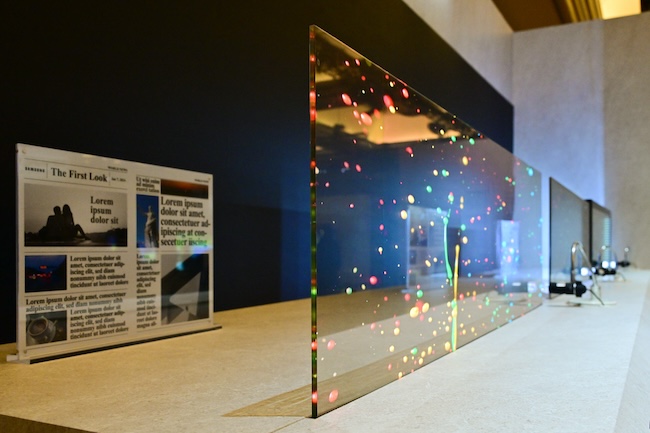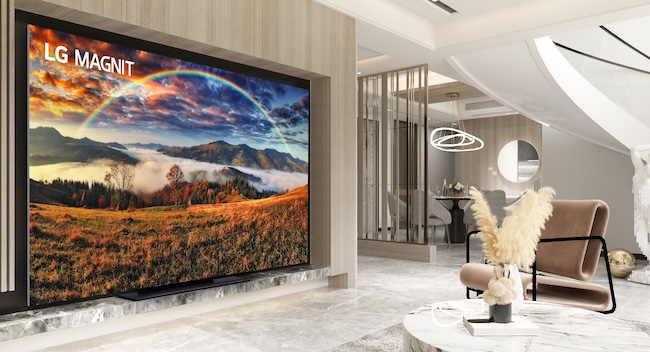
Samsung Electronics recently showcased the world’s first transparent micro light-emitting diode (LED) at CES 2024. (Image courtesy of Yonhap)
SEOUL, Jan. 22 (Korea Bizwire) — Samsung Electronics recently showcased the world’s first transparent micro light-emitting diode (LED) at CES 2024, the world’s largest consumer electronics and IT exhibition, drawing significant attention to the potential mass adoption of micro LED technology.
However, the high cost of micro LED TVs, previously exceeding 100 million won per unit, has been a significant barrier to widespread demand. The industry is now focusing on technological advancements that could reduce costs and increase market demand.
Samsung Electronics unveiled the prototype of a transparent micro LED display at the ‘Samsung First Look 2024′ event held at Caesars Palace in Las Vegas on January 7. While still not ready for commercialization, and with Samsung not disclosing details like transparency levels, the prototype successfully captured the attention of the global media gathered at the event.
Micro LED displays, unlike liquid crystal displays (LCDs) that require backlighting, offer superior image quality without a backlight or color filters. They are based on inorganic materials, which offer durability and are free from burn-in issues commonly associated with organic light-emitting diodes (OLEDs).

The industry is now focusing on technological advancements that could reduce costs and increase market demand. (Image courtesy of Yonhap)
Micro LEDs can be used for both home and industrial purposes, and their bezel-less, modular design allows for customization in various shapes and sizes to fit different spaces.
The production complexity of placing hundreds of thousands of hair-thin LED chips accurately on a glass substrate contributes to the high manufacturing costs, making mass-market adoption still challenging.
For instance, Samsung’s 89-inch micro LED TV launched last year was priced at 130 million won. The addition of transparency technology to micro LEDs is expected to further increase the cost.
Opinions on the mass adoption of micro LED technology vary, with some appreciating Samsung Electronics’ development success itself.
Park Hyung-sei, head of LG Electronics’ Home Entertainment business division, commented on the current state of the market during a press meeting in Las Vegas on January 10, “Micro LED is still at a price point difficult for business-to-consumer (B2C) transactions.”

LG Electronics has been showcasing its ‘LG Magnit’ micro LED signage since 2020. (Image courtesy of LG Electronics)
LG Electronics focuses on OLED for sizes below 100 inches and concentrates on micro LEDs only for larger sizes.
LG Electronics has been showcasing its ‘LG Magnit’ micro LED signage since 2020, primarily for business-to-business (B2B) applications like retail stores, conference rooms, and virtual productions.
Park views transparent micro LED as more of a B2B domain, but remains observant of future technological advancements.
Samsung Electronics remains optimistic about reducing micro LED prices. Han Jong-hee, head of Samsung’s DX division, stated, “Micro LED prices have dropped by a third in four years since their introduction. Once commercialized, prices will decrease significantly.”
He suggested increasing production facilities and expanding the market to lower material costs as ways to reduce prices.
Han went on to explain, “When LCDs first came out, a 40-inch display cost $9,999. As technology advances, prices will drop and adjust according to consumer needs.” He noted that while transparent displays have existed since LCDs, the technology has only now reached commercialization levels with micro LEDs.
The industry expects micro LEDs to be adopted in high-resolution devices like extended reality (XR) and wearable devices like smartwatches.
According to market research firm Omdia, this year’s micro LED panel shipments are expected to reach 290,000 units, with smartwatches accounting for 99.8% of this figure. Next year, micro LED panel shipments are projected to increase to 1,849,000 units.
Kevin Lee (kevinlee@koreabizwire.com)






